
Darwin's Precursors and Influences
1. Transmutationism
by John Wilkins![]()

![]()
Previous |
Contents |
Next |
The view that species change is an old one, but in the scientific tradition it derives from Lamarck, who made it a more or less respectable view. Numerous earlier writers, including Linnaeus, Maupertuis, Buffon, and even Aristotle, had suggested that some species might give rise to new species, but this was contrary to church teaching and was a dangerous view to hold in Christian Europe. There were hints of species transmutation in the ancient Greek writers, but their views tended to ignore heredity, and so do not count as truly evolutionary.1
Jean Baptiste de Lamarck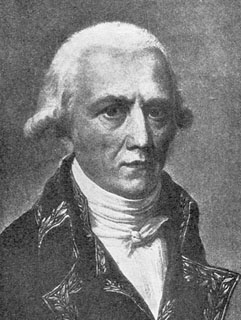
In the late 18th century, Cuvier in France had described extinct mammals and Blumenbach in Germany had described fossil shellfish that were now extinct. In 1800, Lamarck adopted and modified the neo-Platonic view of Bonnet of a gradual series or scale from inanimate matter to the most perfect being, and added a principle of transition over time. Moreover, Lamarck added that the transition was not a ladder, but a branching tree, with new forms created. However, Lamarck asserted the existence of a number of qualitatively separate trees for different lineages - several for animals and several for plants and other forms of life - rather than a common tree for all life. Lamarck accepted the then widely-held view of the possibility of the spontaneous generation of new living forms from inanimate matter, which was later disproven by Pasteur in the late nineteenth century. (Pasteur's "disproof" of spontaneous generation really only showed that modern organisms such as bacteria did not arise from nothing, not that life had always to come from life, as is sometimes asserted by anti-evolutionists. Likewise Spallanzini's 17th century experients on flies and mice showed the same thing.)
Lamarck held that there were two causes of evolutionary change: a drive towards perfection, and a capacity of organisms to react to the environment and adapt to the needs of the present situation. Mayr says that Lamarck was neither a vitalist nor a teleologist, meaning that he neither held that life was a mysterious non-physical force, nor that it had any goal or direction, contrary to later popular misconceptions. Instead, he saw the environment as the driving force of evolution (unlike Darwin, who considered that the environment sorted out the end results of natural variation). Lamarck also held that organs were strengthened in the way they were inherited through use, and weakened through disuse (a view that Darwin also accepted).
Lamarck has been misunderstood, in the light of later developments, to have thought that change accrued from the intentions, or volitions, of organisms. Darwin's contemporary Spencer, and Darwin himself, thought this of Lamarck (they disagreed about its truth), and those called "Neo-Lamarckians" in the late 19th century also held this view and attributed it to Lamarck. Mayr2 argues it was due to mistranslation of the word besoin to "want" rather than "need". Many of the misunderstandings of Lamarck's views were due to Lyell's discussion in his Principles of Geology, volume 2.
Lamarck's views fared badly in his native France. The great anatomist Cuvier ridiculed his views, and promoted instead a view of catastrophic changes followed by acts of spontaneous generation, influencing later French biologists. Cuvier rejected evolution not for religious reasons, although that charge is often made, but for what was then relatively good evidentiary reasons: there was no apparent increase in the perfection shown by the fossil record. Since Lamarck held that there was a drive to perfection, the fossil record should show this. Cuvier was also committed to the prevailing essentialism (the view that species had essences that did not change). Only Geoffroy in France followed in the evolutionary vein, and his over-ambitious attempt to devise a comparative system of forms that applied to all the animal kingdom lost him support.
Darwin did owe Lamarck, indirectly. Lamarck's views were revisited by the amateur Scots writer Robert Chambers (publisher of Chambers' Cyclopaedia) in 1844 in a book published anonymously: Vestiges of the Natural History of Creation. This book caused a major uproar in England, due in part to the social upheavals of the time, for evolutionism was connected to calls for radical social reform and was seen as a dangerous view. Chambers' work was clearly amateurish, and geologists of his day made short work of many of his claims (biology as such did not then exist as a separate science, although the word had been coined in the late 18th century, and popularised by Lamarck). Darwin read the Vestiges closely, and he determined not to be torn apart by the scientific community in the same way, which goes some way to explaining why it took him 20 years after his first inspirations in 1837/38 to publish his views. Chambers was committed to the Quinary system of William Macleay, which divided life into five ideal classes, and only within which did evolution occur. He worried that Lamarck's approach would lead to irregularity in the structure of life3. Although Chambers denigrated Lamarck, his views were not very different, and in later editions he even included a mechanism not unlike Lamarck's once he had abandoned Macleay's system.
Charles Lyell (right)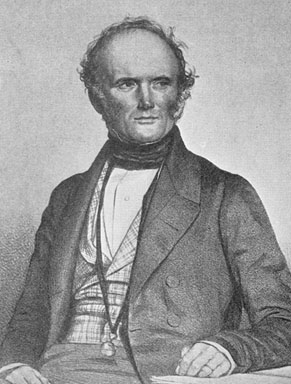
Moreover, in 1832, Charles Lyell published the second volume of his influential Principles of Geology, which Darwin received while on the Beagle voyage the same year. Much of it was devoted to attacking Lamarck's views, using Cuvier's arguments. Finally, and admitted by Darwin himself, his good friend at Edinburgh University where he studied medicine, Robert Grant, was one of the few enthusiastic Lamarckians in Britain, and expounded it to Darwin many times. Darwin remarked in his Autobiography that he may have been predisposed to consider evolution from having heard Lamarck so praised4.
What Darwin gained from Lamarck regarding evolution was a view of branching change, although it is likely that he came to these views on his own, initially through his field observations during the voyage of the Beagle and reflections afterwards. Lamarck had created a climate in which such views were possible. In 1802, William Paley published his Natural Theology, which was an extended argument for the existence and activity of God from the evidence of design in the natural world, and similar views were argued in the Bridgewater Treatises (1833-1836) by a series of theologians and scientists. But the cat was out of the bag, and science became increasingly autonomous of theological constraints, moving to more naturalistic explanations. Lamarck's own explanations were clearly unsatisfactory, but the need to explain adaptation was largely created by Lamarck. Responding to claims he had simply restated Lamarck's doctrine, Darwin stated that he had got not a fact nor idea from Lamarck's work5.
Darwin's own grandfather, Erasmus Darwin, wrote an extensive book outlining a transmutation view, and it is known that Darwin had read this as a teenager6. However, when he started on his naturalist research, Darwin was a firm believer in the static nature of species, and Erasmus had little influence on the biological researches that followed. Whatever Erasmus's direct influence, Charles wrote that he first encountered the idea of species transformation when he read his grandfather's works7.
Another important scientist who preferred to explain change in terms of forces acting in the present day was Charles Lyell, whose views on gradual geological change were termed "uniformitarianism" by the philosopher William Whewell in 1832, in distinction to Cuvier's which Whewell termed "catastrophism". Over the course of the century, these views moved increasingly towards each other until there was little to distinguish them, but at first the dispute was acrimonious.
Since geology then included what we now call paleontology, the study of fossils, Lyell had a lot to say about biological change over the time scales of geology, and flirted with transmutation for most of his career, although it was not until the Origin was published that he eventually submitted. Darwin's views were directly informed by Lyell (Darwin took a copy of volume 1 of Lyell's Principles of Geology with him on the Beagle voyage, and received volume 2 en route), although Lyell at the time was, in Mayr's words8, "an essentialist, a creationist, and his whole conceptual framework was adamantly opposed to Darwin's". Lyell and Darwin were good friends and Darwin sought to gain Lyell's approval.
Herbert Spencer, a railway engineer who wrote rather turgid "synthetic" philosophy, invoked evolution as a universal principle several years before Darwin published the Origin. Spencer's evolution was a principle of necessary differentiation and progress from less to more complex. Mayr says, "Spencer's views contributed nothing positive to Darwin's thinking; on the contrary, they became a source of considerable subsequent confusion"9. Spencer donated the phrase "survival of the fittest" after Wallace had convinced Darwin that the implications of deliberate and intentional selection in the term "natural selection" were misleading, as indeed they were to Darwin's contemporaries10. Spencer was privately and sometimes publicly ridiculed by Darwin and Huxley for the absence of real facts in his philosophy of nature. Huxley once said that Spencer's idea of a tragedy was a deduction spoiled by a fact.
Spencer's views influenced thinkers until the present day, especially Karl Popper (1972). They most resembled the popularly-held views of evolution that persisted from Lamarck and the German tradition of Naturphilosophie, and involved belief in progressive development through stages to greater complexity, views rejected by Darwin but influential in the subsequent "revolution" that followed 185911.
Finally, a mention of the influence of recapitulation theory is in order. This view was developed most famously from the earlier ideas of embryologist von Baer (in 1828; see Richards 1992 for examples of other possible originators of this view, including Friedrich Tiedemann) by Ernst Haeckel, who established himself as a spokesperson for "Darwinism" in Germany. Haeckel's version proposed that embryos recapitulate the "stages" of "lower" animals of the class concerned (von Baer's stated only that changes shared by a smaller class of organisms who were related to each other occurred later in development than changes shared by broader classes; so the development of hair would occur earlier than the development of placental tissues, for example). There are two obvious ways to interpret this: one is that embryos recapitulate (pass through) the same stages of a heirarchy of (eternal or ideal) types, but which are not historical stages so much as grades of "perfection" or "complexity", while the historical view is that these similarities of embryos represents retained stages from actual ancestors (i.e., from the phylogeny, or ancestral lineage, of the organism).
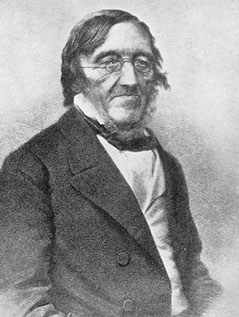 Karl Ernst von Baer (left)
Karl Ernst von Baer (left)
Von Baer showed that embryos of species that were similar went through similar stages, and this work is not entirely discredited, although it has been greatly modified in the light of later research12. The modern view is that embryos tend to retain embryological (i.e., not adult) features of ancestors and its import for evolution is greatly reduced, now explained by common descent and natural selection rather than providing evidence for these theories. However, since selection can act even in utero (for example in terms of disease resistance), there is no expectation by modern evolutionary theory that all features are retained. Haeckel's dream that we could reconstruct the primordial ancestor of a group of related organisms from the early embryos of those organisms is now entirely discredited - in fact it was challenged even in his own time, although it found its way into the textbooks.
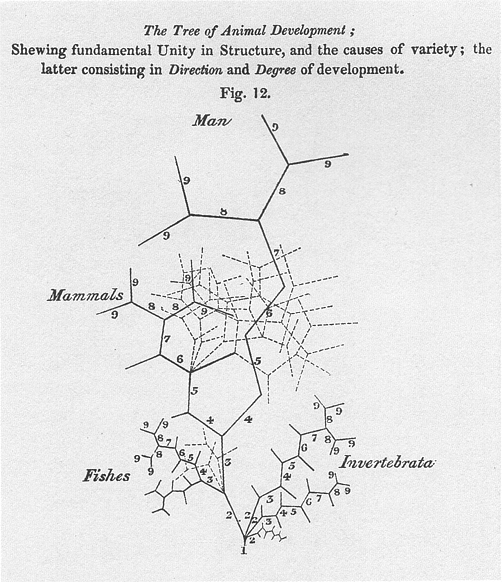 |
Left: A diagrammatic representation of von Baer's theory that the more common the developmental character for a group of animals, the earlier in development it occurs. Compare this to Darwin's initial sketches of the evolutionary tree. From Richards 1992. |
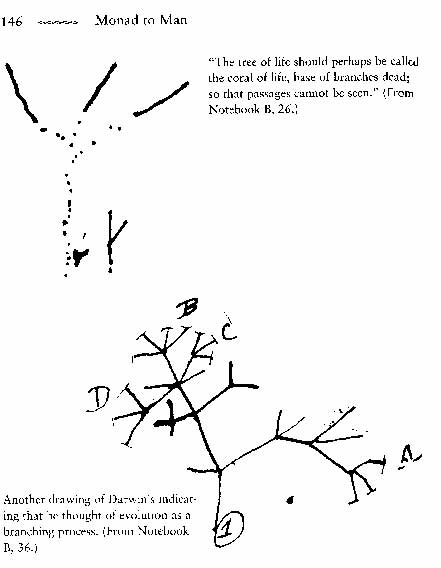 |
Darwin's sketchesfrom the same year (from Ruse 1996) |
Evolution as it spread post-Origin throughout Europe and North America was based upon the analogy between the development and life-cycle of a single organism ("ontogeny") and that of a species ("phylogeny"). This popular view, quite in opposition to Darwin's13, held that species had a "life-cycle" and that each species, or lineage of species, were predetermined in the stages they would pass through. Bowler (1982, 1988) argues that these views reflected the pre-Darwinian versions of evolution, not Darwinian views (cf. also Gould 1977, Hull 1973, Mayr 1982. I think Richard's 1992 thesis, while correcting some excesses of interpretation, does not make the case that Darwin was a progressionist in this sense, and likewise Ruse 1996, although he does make a good case for Darwin's later writings.).
Ernst Haeckel (right)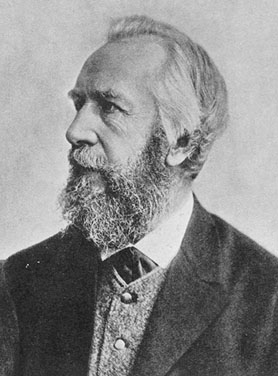
Ernst Haeckel's post-Origin views in particular (the famous and now discredited "biogenetic law" that "ontogeny recapitulates phylogeny" or that embryological development was a recapitulation of the adult stages of ancestors) were based on this analogy of organism and species, for all that he claimed to be in Darwin's school, and were an extension of the work of von Baer (who himself remained opposed to transmutationism even after the Origin was published).
Darwin had read the later work of the embryologists Meckel and Serres as well as an extensive review article of von Baer's work14, but all of these held to a scala naturae view of species (that they were ranked up a predetermined ladder, or scale15) Haeckel's so-called "biogenetic law" was never part of Darwin's theory, although he and Darwin were on good terms16.
1 cf Magner 1994, chapter 8 for a review of these early evolutionists and Mayr 1982 chapter 7 on the judgement that the ancient Greeks did not contribute an evolutionary theory.
2 Mayr 1982, chapter 8
3 Ruse 1979 pp 104-106
4 Darwin 1959, p 49
5 Letter to Lyell in 1859, Darwin 1959, p 153
6 Darwin 1959, p49
7 Richards 1992, cf. also his article in Keller and Lloyd 1992
8 Mayr 1982, p 381
9 Mayr 1982, p 386
10 de Beer 1963, p 178f
11 See Bowler 1988 for a good review of the spread of "pseudo-Darwinism", and 1982 and 1989 for details of pseudo- and anti-Darwinian views after Darwin, and Hull 1973, Introduction.
12 Gould 1977 has the classic discussion, cf. Mayr 1982, pp 472-473, Richards 1992
13 See Richards 1992 for disagreement with this traditional interpretation.
15 Cf. Mayr 1982, pp 476ff
16 Mayr 1982, pp 474-475; but see Richards 1992
Previous |
Contents |
Next |

| Home Page | Browse | Search | Feedback | Links |
| The FAQ | Must-Read Files | Index | Creationism | Evolution | Age of the Earth | Flood Geology | Catastrophism | Debates |